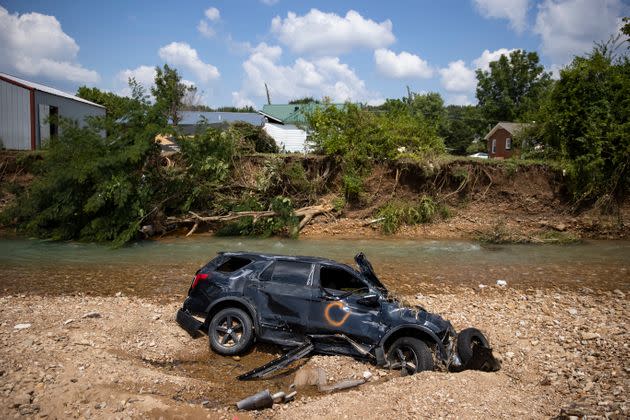The Climate Crisis Brought Us Megadroughts, But Also Megafloods
Americans have been reading all summer about the megadrought gripping the Western United States — a devastating event that has required water cuts along the Colorado River and which climate change has undoubtedly made worse.
In the Eastern U.S., a different kind of climate threat has wreaked havoc over the last week: megafloods.
Tropical Storm Fred dumped more than 10 inches of rain in western North Carolina, triggering flash floods that killed at least five people. In Tennessee, at least 22 people were killed and more than 200 homes destroyed after a giant storm unleashed up to 17 inches of rain, causing rivers to quickly swell. In the Northeast, slow-moving Tropical Storm Henri drenched New York City and other major metropolitan areas, causing as much as $4 billion in losses. Central Park saw nearly 2 inches of precipitation in a single hour, likely the most of any one-hour period on record.
The string of U.S. floods comes about a month after catastrophic flooding in Germany and Belgium, which left a trail of destruction and killed nearly 200 people.
Megadroughts and megafloods might seem like opposites, but they are in fact two sides of the same deadly coin. As human greenhouse gas emissions drive up global temperatures, the world can expect both extreme events to become more frequent and severe, warned a recent landmark report from the United Nations’ Intergovernmental Panel on Climate Change.
“There’s increasing evidence for an overintensification of the water cycle,” said Alex Ruane, a NASA scientist and a lead author of the IPCC report’s chapter on regional impacts. “Water is moving through the climate system faster than it used to. That means it is being evaporated into the air faster, it’s being moved around, and it’s raining down harder when it does rain. All of these things are actually connected to the same factor, which is that warmer air has a tendency to hold more moisture.”
The current conditions across the country — drought in the West and torrential precipitation in the East — highlight a trend that scientists have been documenting in recent decades and offer a glimpse of what to expect in the coming years.
“These are examples of the type of conditions that we think are going to be more and more widespread and pronounced with each increment of climate change,” Ruane said.

The crisis is already affecting weather in “every region across the globe,” from grueling heat waves and drought to more intense tropical cyclones and precipitation events, the IPCC said. Since the 1950s, heavy precipitation events have increased across most land areas, with human climate change “likely the main driver,” the report states.
It’s difficult to pinpoint the extent to which anthropogenic warming is responsible for a given extreme weather event, be it a flood, hurricane or heat wave. But advances in attribution science have allowed experts to state unequivocally that such events would have been less likely if not for planetary warming.
The severe flooding in Germany, for example, was between 1.2 and 9 times more likely due to climate change, according to a rapid attribution study. The deadly heat wave in the Pacific Northwest last month would have been “virtually impossible” without it, concluded another.
The frequency of so-called “100-year” and “500-year” flood events has left some scientists questioning whether it’s time to scrap the terminology altogether. The term “100-year flood” doesn’t mean the event can be expected once every century, but rather is of a magnitude that “statistically has a 1-percent chance of occurring in any given year,” as the U.S. Geological Survey explains on its website. In other words, the probability of a 100-year flood occurring in a given location this year is 1 in 100.
Houston, Texas, experienced back-to-back-to-back “500-year” events in 2016, 2017 and 2018. The recent flooding in Tennessee surpassed even the “1,000-year” benchmark, according to the National Weather Service.
“We’re seeing more and more of these extreme events globally,” Tom Terry, a meteorologist in Orlando, Florida, wrote on Twitter. “This is a tell-tale sign of global climate change.”
This article originally appeared on HuffPost and has been updated.




